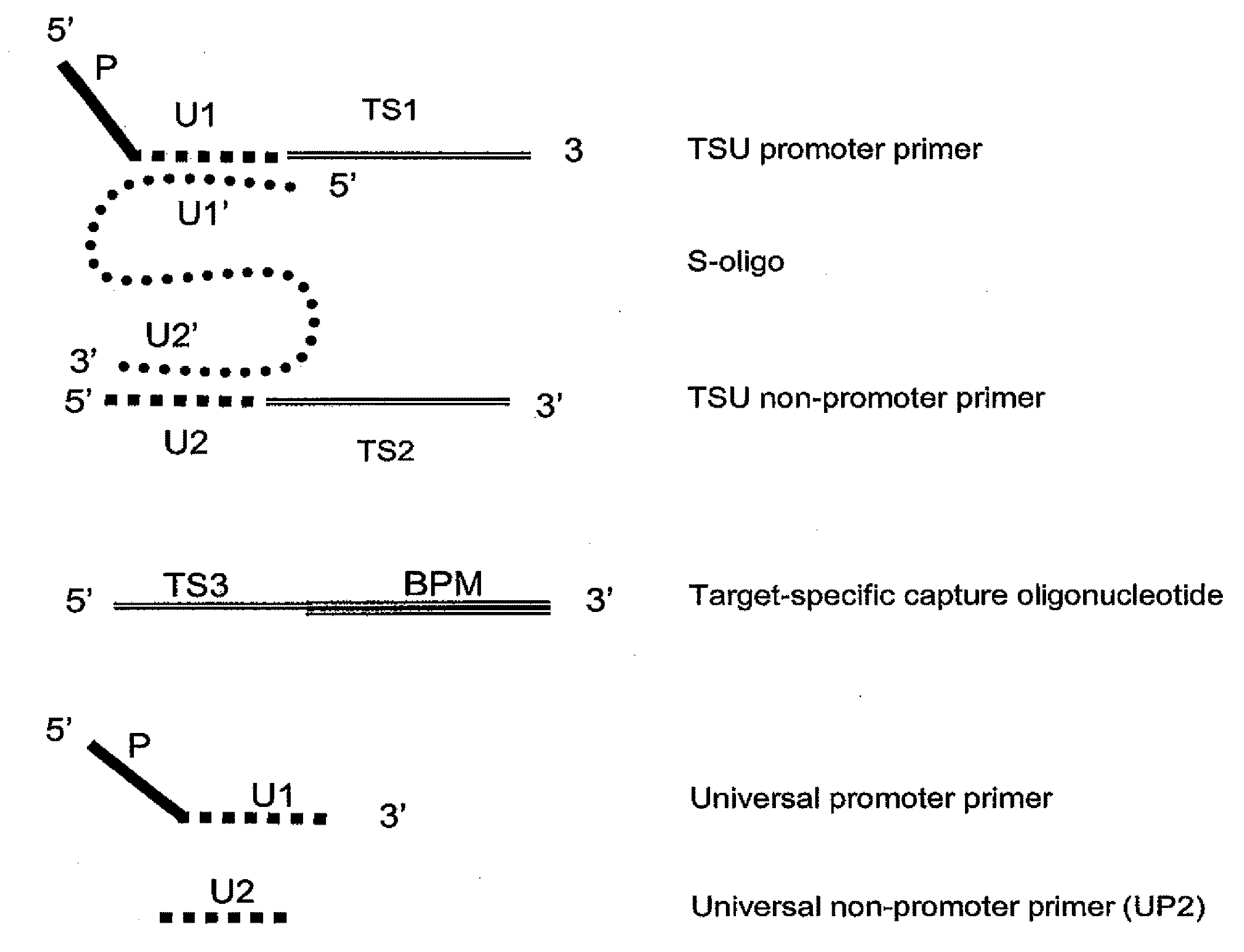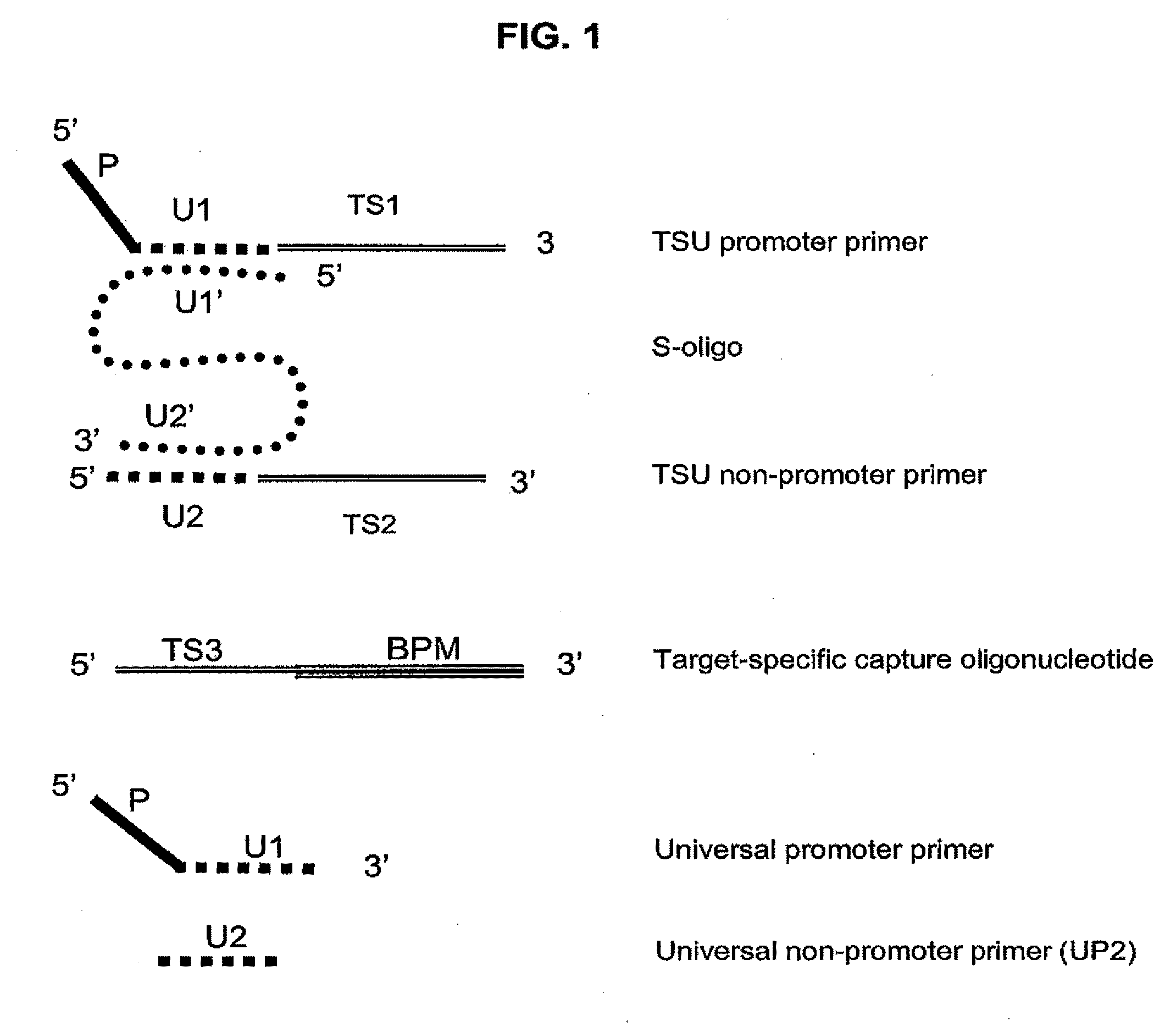Methods and compositions for nucleic acid amplification
- Summary
- Abstract
- Description
- Claims
- Application Information
AI Technical Summary
Benefits of technology
Problems solved by technology
Method used
Image
Examples
example 1
Universal TMA (uTMA) System for Detection of Multiple HPV Types
[0119]This example shows the performance of an embodiment of universal isothermal amplification referred to as “half uTMA”, in a system to detect at least 12 human papillomavirus (HPV) types associated with a high risk of developing cervical cancer (high-risk HPV types). The target was either 200 or 1,000 copies / reaction (c / rxn) of a single in vitro transcript of the specified HPV type. Target capture, amplification and probe detection by using hybridization protection assay (HPA) which were all performed substantially as described earlier (U.S. Pat. Nos. 6,110,678 and 6,534,273 for target capture, U.S. Pat. Nos. 5,399,491 and 5,554,516 for TMA, and U.S. Pat. Nos. 5,283,174 and 5,639,604 for HPV). The target capture mixture contained in the TC reagent 2 pmol each of target capture oligonucleotides of SEQ ID Nos. 28-32. The target capture mixture additionally contained 5 pmol each of HPV TSU T7 promoter primers of SEQ ID ...
example 2
Sensitivity of Universal TMA System for Detection of High-Risk HPV Types
[0122]This example shows the performance of an embodiment of universal isothermal amplification referred to as a “full uTMA” in a system that includes two universal sequences to detect 12 high-risk HPV virus types. The target was either 200 or 2,000 copies / reaction of a single in vitro transcript of the specified HPV type. Target capture, amplification and HPA detection steps were all performed substantially as described in Example 1 except that different TSU primer combinations were used. The target capture mixture contained 2 pmol each of TC oligonucleotides of SEQ ID NOs. 28, 29, 30, 31 and 32. The target capture mixture additionally contained S-oligonucleotide TSU primer complexes designed to detect the 12 high-risk HPV types. The TSU primer complexes were formed by hybridizing 5 pmol of TSU T7 promoter primer with 10 pmol of S-oligonucleotide of SEQ ID NO:35 and 15 pmol of the corresponding TSU non-T7 prime...
example 3
Detection of HPV RNA from Clinical Samples Using a uTMA System
[0125]This example shows that the “full uTMA” system as described in example 2 is capable of detecting HPV RNA from cervical swab or scraping samples preserved in alcohol-based liquid media (CYTYC™). The procedure was performed as described in Example 2, except that 100.micro.l of the liquid media sample was added to 500 μl of target capture mixture in the target capture reaction.
[0126]The presence of both high- and low-risk HPV was determined by HPV DNA PCR and visualized as bands following separation by agarose gel electrophoresis. Identity of any HPV viral RNA present in the samples was confirmed by DNA sequencing. Samples that produced greater than 20,000 RLU using the full uTMA system, were scored as positive. Table 3 shows the correlation between HPV type and full uTMA amplification results. Positive PCR that resulted in highly visible bands were scored as “+”, weak bands as “+ / −”, and negative results (no visible b...
PUM
| Property | Measurement | Unit |
|---|---|---|
| Fraction | aaaaa | aaaaa |
| Fraction | aaaaa | aaaaa |
| Fraction | aaaaa | aaaaa |
Abstract
Description
Claims
Application Information
 Login to view more
Login to view more - R&D Engineer
- R&D Manager
- IP Professional
- Industry Leading Data Capabilities
- Powerful AI technology
- Patent DNA Extraction
Browse by: Latest US Patents, China's latest patents, Technical Efficacy Thesaurus, Application Domain, Technology Topic.
© 2024 PatSnap. All rights reserved.Legal|Privacy policy|Modern Slavery Act Transparency Statement|Sitemap



